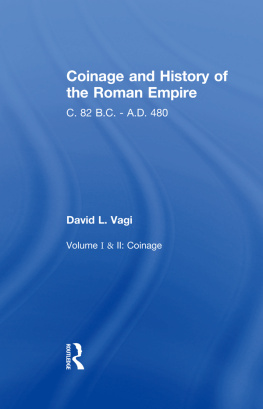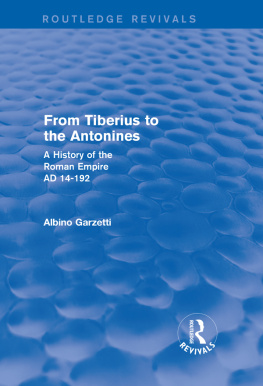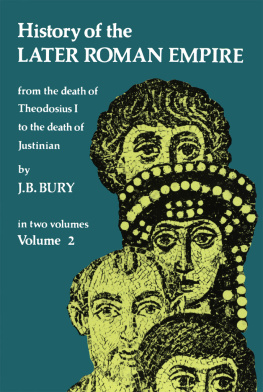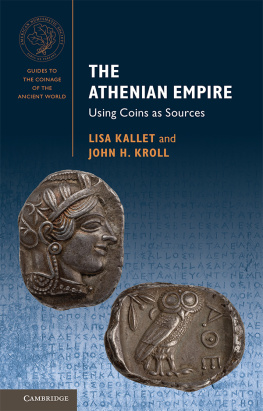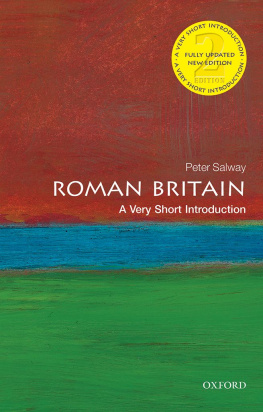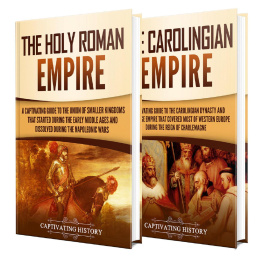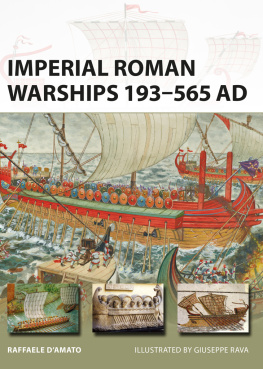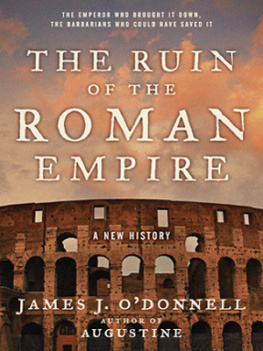
COINAGE AND HISTORY OF THE ROMAN EMPIRE

COINAGE AND HISTORY OF THE ROMAN EMPIRE
C. 82 B.C. A.D. 480
VOLUME I: HISTORY
DAVID L. VAGI

First published 2000 by FITZROY DEARBORN
This edition published 2015 by Routledge
2 Park Square, Milton Park, Abingdon, Oxon OX14 4RN
711 Third Avenue, New York, NY 10017
Routledge is an imprint of the Taylor & Francis Group, an informa business
Copyright 1999 by David L. Vagi
All rights reserved including the right of reproduction in whole or in part in any form.
British Library and Library of Congress Cataloging-in-publication data available
ISBN: 978-1-138-99907-7 (vol 1) (hbk)
ISBN: 978-1-57958-316-3 (set) (hbk)
Permission to use illustrations was granted by the following companies: Classical Numismatic Group, Inc.; Leu Numismatik; Numismatic Fine Arts, Inc.; Numismatica Ars Classica; Sotheby's (New York and London); Miinzen und Medaillen; Italo Vecchi, Ltd.; and Superior Galleries.
And by the following individuals: Rick Witschonke, David Hendin and the author.
Certain numismatic numbering systems are referenced by kind permission of British Museum Publications, Bibliotheque nationale de France, Cambridge University Press, The Danish National Museum, Dumbarton Oaks Research Library and Collection, David Hendin, and Spink and Son, Ltd.
Permission to reference the catalog numbering system in this book is freely granted by David L. Vagi and requires no prior written permission, providing the user identifies the catalog numbers by proceeding them with the name Vagi, and that the user also cites the title and author of this book in that same work.
The Mint map was substantially modified from an original reproduced with the kind permission of Andromeda Oxford Ltd 1999.
Analysis and pricing information are based on historical information and market conditions. No information in this book should be construed as predictive. Past performance is not a guarantee of future performance. This work is for reference purposes only, and does not constitute an offer to buy or sell any pieces described herein.
Book design, typography and pre-press by STUDIO 31, INC.
Dedicated in Living Memory
to
ESTHER IVANKA
19151996
TABLE OF CONTENTS
BY ROBERT W. HOGE
CHAPTER 1:
COLLAPSE OF THE REPUBLIC (IMPERATORIAL PERIOD), C. 8227 B.C.
CHAPTER 2:
THE JULIO-CLAUDIANS, 27 B.C. A.D. 68
CHAPTER 3:
THE CIVIL WAR OF A.D. 6869
CHAPTER 4:
THE FLAVIANS, A.D. 6996
CHAPTER 5:
THE ADOPTIVE EMPERORS AND THE ANTONINES, A.D. 96192
CHAPTER 6:
CIVIL WAR AND THE SEVERAN-EMESAN DYNASTY, A.D. 193235
CHAPTER 7:
CRISIS AND DECLINE, A.D. 235268
CHAPTER 8:
RECOVERY OF EMPIRE, A.D. 268285
CHAPTER 9:
THE SEPARATIST EMPIRES
CHAPTER 10:
THE TETRARCHY, C. A.D. 284313
CHAPTER 11:
THE CONSTANTINIAN ERA, C. A.D. 313364
CHAPTER 12:
THE WESTERN ROMAN EMPIRE, A.D. 364480
CHAPTER 13:
THE EASTERN ROMAN EMPIRE, A.D. 364491
Were it practical to do so, this section would be as long as the book itself. After all, knowledge does not materialize from thin air. Thanks must first be given to the historians of antiquity, whose writings provide the basis of our knowledge, and to those who produced the coins which are the focus of this work. Every word in this book has a source, however remote, and even those portions which may come under the heading of original thought are hardly original, for such ideas can only be developed in the context of existing knowledge. Now, to acknowledge some specific debts.
Contributions: Of the many people who contributed to this book, there are five to whom I am most deeply indebted. Foremost are Robert Hoge and Jim Wasserman, both of whom suffered with me since the start of this project. My mentor Robert Hoge, curator at the American Numismatic Association, reviewed every page of the text with selfless dedication. He searched for errors large and small, conceptual and technical and offered invaluable advice and encouragement. His considerable talents as a numismatist, historian, literary stylist and grammarian (in both English and Latin) were put to full use. The books designer, James Wasserman, took on the project as if it were a personal jihad, not just another job. His eye for composition and his attention to detail have made this book appear magnificent even when its contents fall short. His dedication far exceeded any normal expectations, and all who find the book pleasant to the eye owe a hearty thanks to Jim. I am also deeply indebted to three other of my colleagues Alan Walker, Curtis Clay and Victor England each of whom made important contributions. Though their impacts cannot be fully appreciated without comparing the final product to early drafts which they reviewed, the reader may rest assured that without their help this would have been a significantly flawed work.
Thanks are also due to those who contributed in their areas of specialty: Rick Witschonke (the Imperatorial period), Matthew Kreuzer (the Julio-Claudians; and especially in helping advance the idea of Livilla on coinage), Kerry Wetterstrom (Roman Egypt), Lawrence Adams (Kingdom of the Bosporus) and Richard McAlee and Michel Prieur (Roman Antioch). I am also indebted to Herb Kreindler and Dennis Kroh, both of whom reviewed extensive portions of the book. For their help in a variety of matters I would like to thank Lawrence Adams, Marty Armstrong, James Beach, Simon Bendall, John Bergman, Harlan and Aaron Berk, Mike Bezayiff, Lucien Birkler, Jan Blamberg, Eldert Bontekoe, John Burnham, Tom Cederlind, Greg Cole, Thomas Curtis, Ben Damsky, Kirk Davis, the Davissons, Ralph DeMarco, Nick Economopoulos, Tom Eden, Rob and Tory Freeman, Eric Gold, Ira Goldberg, Dieter Gorny, Michael Harlan, David Hendin, Silvia Hurter, Stephen Huston, Bill Kalmbach, Jonathan Kern, Frank Kovacs, Matthew Kreuzer, Brian Kritt, Dennis and Desiree Kroh, Peter Lampinen, Hubert Lanz, John Lavender, Cathy Lorber, Constantin Marinescu, Eric McFadden, William Metcalf, David Michaels, David Miller, Barry Murphy, Wilhelm Miiseler, John Pett, Rick and Kent Ponterio, Paul Rabin, Steve Rubinger, Roberto and Arturo Russo, Arnold Saslow, John Saunders, Wayne Sayles, David Sear, Fred Shore, Jon Subak, Richard Swan, Tom Tesoriero, David Tripp, John Twente, Italo Vecchi, Hans Voegtli, Edward Waddell, Bill Warden and Kerry Wetterstrom. Special thanks are due to all of the researchers who have produced auction catalogs with useful notations. To those who, in error, I have failed to thank, I offer my sincere apologies; rest assured that my gratitude is not diminished because of the oversight.
For the encouragement and practical advice that transformed this project from an idea into a going concern, I am indebted entirely to David Hendin, who freely shared his expertise in both publishing and numismatics. For initiating the process with Amos Press I thank Beth Deisher and Brad Reed, both of whom saw promise in my proposal. For carefully reviewing the text for syntactic errors I am indebted to Suellen Ruttkay and Bill Gibbs of Coin World and to Casey Corsa. Thanks are also due to Ann Marie Aldrich and Bill Corsa, whose patience and confidence through understandably strained at times were essential to the success of this project.
Next page
